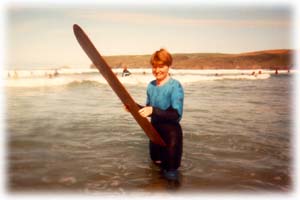'We do have one with handles cut into the rails and a slight bottom concave in the tail.
Some of the Oxenden boards from 1920s Jersey were hand carved like traditional Hawaiian...' That's really interesting Pete, would love to see some of those details, would you be able to share any images?
What are the origins of the boards with the bottom tail concave and what kind of timber are they made from?
Andy Bick's Paipo boards are really a good example of timber shaped prone surfing vehicles, he also seems to be a lovely chap which is most encouraging. I will be visiting Andy for tea and timber talk quite soon and will provide you all with an in depth report. His site can be accessed at www.paipoglide.com
Mods and Rockers:
The ply bellyboards that we might normally encounter on the beach have quite a steep rocker in the nose.
I have been riding boards both with and without this rocker and have found the flatter boards much faster. The flatter boards also seem to be thinner and more flexible (especially the non ply variety) and I feel it's the flex that really makes riding them so much more dynamic. Its possible to create a negative rocker when stuck at the top of a wave which will assist in making the initial stages of the drop down the face. I would love to hear about your own experiences of the various rockers and stiffness of timber available to ride.
What is your opinion on the rocker debate?
Could there be a perfect rocker curve for the British seaside?




